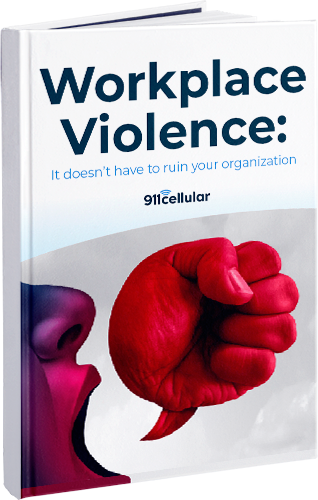Workplace Violence: It doesn't have to ruin your organization
The unfortunate trend of workplace violence
Workplace violence has been a major concern for healthcare institutions and businesses for decades. This not-so-secret problem has been the cause of many deaths, serious injuries and time away from work… all of which costs organizations millions of dollars in revenue each year.
The industry most affected by workplace violence is healthcare… and it’s not even close. About 1 in 4 workplace violence incidents occur outside of the healthcare industry! That means about 75% of all workplace violence incidents are directed toward healthcare workers.
This appalling statistic is made even worse by the fact that many workplace violence incidents that occur don’t even get reported. Unfortunately, this trend of underreporting comes primarily from the healthcare industry and the expectations that go along with obtaining a job as a nurse or caretaker. It’s suspected that nearly 25% of all workplace violence incidents go completely unreported.
Particularly in healthcare, the cost of workplace violence to the institution itself can be astronomical. Just a few incidents can increase insurance premiums for good. While morale and worker satisfaction can take a huge hit. This loss of faith in a hospital’s ability to protect its workers will have a far-reaching impact on the institution’s revenue-generating capabilities.
It’s estimated that hospitals in the United States spend over $425 million each year as a result of workplace violence (staff turnover accounting for over $230 million, medical care and indemnity accounting for over $45 million, disability and absenteeism accounting for over $90 million). Turnover rates for nurses and other healthcare workers can be so severe, that the cost of replacing a single employee can be greater than $100,000!
Looking for workplace violence prevention solutions?Find yours today
The increasing threat of violence against employees has caught the attention of institutional leaders over the years, and there are currently plenty of solutions in place to reduce the impact of this violence. But still, no single solution or even a combination of solutions has the ability to eliminate the threat completely.
So let’s talk about workplace violence… how it impacts those involved, how it can be reduced, the pros and cons of the different types of solutions out there, and what you can do as an individual to protect yourself from the looming threat of becoming a potential victim (without relying on your organization to protect you).
Identifying workplace violence
Before trying to wrap our heads around the complex topic of workplace violence in its entirety, it’s important to understand how to identify and define workplace violence. Though workplace violence can come in many forms, the U.S. Department of Health & Human Services identifies 4 primary categories:
- Criminal Intent
- Customer/Client
- Worker-on-Worker
- Personal Relationship
Criminal Intent
With this first type of workplace violence, the perpetrator has no connection or history of a personal relationship with the business or any of its employees. There is usually a crime committed alongside the violence that ensues. An example of this type of violence would be if a nurse is assaulted in a parking garage.
Customer/Client
With this type of workplace violence, the perpetrator is either a customer, client or patient (in a healthcare setting). This can also include the friends and family members of patients. This type of workplace violence is particularly common in healthcare settings and more frequent in emergency rooms, psychiatric care environments, waiting rooms and geriatric care settings.
Worker-on-Worker
Worker-on-Worker violence is sometimes referred to as lateral violence and includes bullying, verbal abuse, vindictive language and humiliating treatment. This type of violence is more common with supervisors or higher-ups directing this behavior at workers who are ‘beneath them’.
Personal Relationship
This last type of workplace violence is when the perpetrator has (or had) a personal relationship with the victim outside of the workplace.
Creating a plan
Once you understand the different types of workplace violence, then you can begin to make a plan for how to address these unfortunate situations when they arise… or (hopefully) prevent them from even happening in the first place.
Emergency Action Plan
Emergency Action Plans (EAPs) are a requirement for many businesses, but not all. Even if you’re not required to have an EAP in place, it can drastically reduce your organization’s risk level, so it’s probably a smart idea to at least consider implementing one.
An EAP contains many elements, many of which do not necessarily relate to workplace violence. But as workplace violence has become more prevalent over the years, their EAP sections have respectively been growing in size as well.
As a general rule of thumb, your EAP should include workplace violence prevention training and response. Even if your industry doesn’t usually see high rates of workplace violence, excluding it can be risky. Sometimes, all it takes is one incident to massively eat into your earnings… not to mention the perception that it will have on the rest of your employees should an incident occur.
If you’re starting from scratch, it might be a good idea to assess each incident type as you plan for potential workplace violence events:
Prevention for ‘Criminal Intent’ type
To prevent this type of workplace violence, some tips may include: improved cash control, lighting control, access control, surveillance, signage, training on robbery response, training on dealing with people who are aggressive or upset.
Prevention for ‘Customer/Client’ type
To prevent this type of workplace violence, some tips may include: provide adequate staffing and training (recognizing behavioral clues, violence de-escalation techniques, interpersonal communication skills, restraint/take-down techniques).
Prevention for ‘Worker-on-Worker’ type
To prevent this type of workplace violence, some tips may include: maintaining a thorough hiring process (criminal background screens), regular employee training on company policies, training employees how and when to report signs of workplace violence.
Prevention for ‘Personal Relationship type
To prevent this type of workplace violence, some tips may include: training employees to identify victims or perpetrators of intimate partner violence (IPV), maintaining a company culture of support (no penalties for coming forward, confidentiality, safety and security protocols implemented, community service referrals offered).
Active shooter situations
Unfortunately, workplace violence also sometimes escalates to become life threatening. Part of this possibility includes active shooter situations. Active shooters are never a fun topic to talk about, but it’s so important to understand what generally constitutes a good action plan if this tragic situation were to ever arise at your institution.
Active shooter situations can happen at any time, and at any location. They are unpredictable and often require rapid response in order to end without major casualties.
You may have heard the advice, ‘Run, Hide, Fight’ when it comes to active shooter situations. Most experts agree that this is sound advice, but worry that it may sometimes be misunderstood. ‘Run, Hide, Fight’ is not a list of steps to be carried out in order. Instead, this mantra outlines that, if you find yourself in an active shooter situation, you should first seek to run for an exit… if this is not possible or would put you in more danger, then you should attempt to hide from the active shooter… and as a last resort, if you are confronted by the active shooter, fight (fight dirty by going for the eyes, throat and groin, use environmental objects).
Some experts believe that the reason this advice is misunderstood is because the keywords are misleading. For instance, using the words ‘Avoid, Deny, Defend’ may be more fitting.
Avoid
‘Run’ may imply that you should simply run to the nearest exit no matter what. Unfortunately, this advice could be fatal if the exit you run to is blocked or being watched over by the active shooter. Running can also cause a lot of noise, which in turn can attract the shooter to your location before you can exit safely. This is why the word ‘Avoid’ can be used instead.
‘Avoid’ implies that you should leave the area, but safely… avoiding the active shooter at all costs.
Deny
Denying, or hiding, is the next best option if avoiding the active shooter is not possible. This is where you try to be invisible to the active shooter, but also take the necessary precautions just in case they enter your space.
For instance, you’ll want to silence your phone, turn off the lights, lock and barricade the doors if you can, and hide somewhere (ideally behind something that could stop a bullet). Only call 911 if you are certain that this would not get the attention of the active shooter. You’ll also want to plan for the next course of action.
Defend
The final action is to defend (fight) against the active shooter. This is the last resort and never an ideal situation. If this happens though, you need to be quick and ruthless and you will almost certainly be outmatched. Do not fight fair! Go for the soft areas such as the throat, groin and eyes. Also, use objects that you’ve found in the environment if you can.
Technology solutions
Because of the prevalence of workplace violence in healthcare, most (if not all) hospitals have plans and procedures in place to reduce the risk of violence against their employees. The same goes for other industries in which workplace violence is common, though not all businesses see it as a threat worth defending against.
Regardless of the internal policies in place, most institutions must still deploy third-party solutions to help combat the potential for violence. These solutions can include metal detectors, cameras, communication equipment and panic buttons.
Panic button solutions have been widely praised for their ability to not only reduce the amount of incidents that can occur, but also their severity. Let’s go over some of the panic button solutions that exist today and how they can help to directly and indirectly reduce workplace violence.

Learn everything you need to know about healthcare panic buttonsDownload FREE ebook
Workplace panic buttons
Panic buttons come in many different forms. Traditionally, panic buttons were physical buttons that would be installed at specific locations throughout a hospital or workplace. At the time, these were the only panic buttons that existed, and so they worked well for workplaces needing to protect certain employees in vulnerable areas.
But today’s panic buttons are much more versatile and cost-effective, rendering most hard-wired panic button solutions as a thing of the past.
The traditional hard-wired panic buttons have many weaknesses; they’re stationary, expensive to install and repair, and cannot be upgraded or tested easily. Most newer panic button technology gets rid of the physical component altogether, opting for a cloud-based, software solution.
These new and improved software panic buttons are cost-effective, can be rolled-out to just about every area in your institution, and can be upgraded and tested instantly.
Also, because they’re software, they can integrate with third-party devices and other security solutions such as surveillance systems, access control, and communication networks.
Computer and safety app panic buttons
Software panic buttons are so powerful because they take advantage of existing infrastructure and personal devices that both the institution and its employees already own.
Computer panic buttons can be installed as applications on just about any desktop, laptop or tablet across both Mac and Windows operating systems. This versatility allows institutions to cover as many devices as they see fit, protecting employees and areas from workplace violence without having to pick and choose a few select locations.
With mobile safety apps, panic buttons can also be accessed from personal devices such as smartphones, ensuring even quicker access to safety forces when needed.
Wearable (bluetooth) panic buttons
Wearable panic buttons are hardware devices that can be activated to signal for emergency assistance, just like a hard-wired panic button. These devices, however, are usually connected to another device via bluetooth. This allows the wearable to communicate with a smartphone or computer to enable the sending of a panic button signal.
Wearable panic buttons can sometimes be so discrete, that they seamlessly hide within an employee’s badge or within their clothing, making them almost impossible to detect.
Response team(s)
Response teams are an integral part of the workplace violence solution. Without the proper response team communication in place, your dispatchers (if you have them), will struggle to send important information to the people that need it most… those who are able and closest to the scene of the incident.
The information that is being sent to these response teams can be just as important as how the information is being sent. For instance, if dispatchers have to manually transmit location data, this can waste precious seconds in a potentially life threatening situation. Not to mention, there is always the risk of human error.
With certain safety solutions in place, a panic button activation anywhere in your hospital or organization can instantly send out the most relevant information directly to the responders themselves. For instance, let’s say that a computer panic button is activated in the reception area of the emergency department. The nearest security personnel is located just a few hallways away from the activation point. With a proper system in place, this activation will alert our close-by security personnel, dispatch, and other administrators who have opted-in to receive these alerts in real-time. They’ll get this information via text or phone call and it includes the panic button’s location. If the panic button was activated on a mobile phone or laptop, and the person in need moves away from the original location, the team members will see the updated location in real-time.
In a world where workplace violence is ravaging hospitals and businesses, the leaders of these organizations can ill-afford to address the issue with minimal urgency. The solution to workplace violence is not one-dimensional, it is a multi-faceted defense system that combines environmental factors, protocols, and security technology integrations.

Take this guide with you!
Want to access this information anytime? Download the FREE PDF of Workplace Violence: It doesn't have to ruin your organization.


